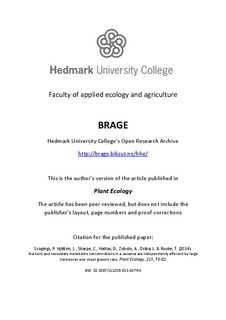| dc.contributor.author | Scogings, Peter F. | |
| dc.contributor.author | Hjältén, Joakim | |
| dc.contributor.author | Skarpe, Christina | |
| dc.contributor.author | Hattas, Dawood | |
| dc.contributor.author | Zobolo, Alpheus | |
| dc.contributor.author | Dziba, Luthando | |
| dc.contributor.author | Rooke, Tuulikki | |
| dc.date.accessioned | 2014-02-04T12:45:35Z | |
| dc.date.issued | 2014 | |
| dc.identifier.citation | Scogings, P. Hjältén, J. , Skarpe, C., Hattas, D., Zobolo, A., Dziba, L. & Rooke, T. (2014). Nutrient and secondary metabolite concentrations in a savanna are independently affected by large herbivores and shoot growth rate. Plant Ecology, 215, 73-82 | no_NO |
| dc.identifier.uri | http://hdl.handle.net/11250/134654 | |
| dc.description | This is the author's version before it was send to the publisher.Therefore it can differ slightly from the punblished version. For the published version, please go to: http://link.springer.com/article/10.1007%2Fs11258-013-0279-6 | no_NO |
| dc.description.abstract | Carbon-based secondary metabolites (CBSMs) such as tannins are assumed to function as plant defences against herbivores. CBSMs are thought to be inversely related to growth rate and nutrient concentrations because a physiological trade-off exists between cellular growth and differentiation, but CBSM concentrations can be altered by herbivory-induced changes in the trade-off. We predicted that a significant interaction exists between herbivory and growth phase, such that the effects of large herbivores (or their exclusion) on nutrient or CBSM concentrations are greatest during phases of rapid shoot or leaf growth. Leaf samples were collected during phases of different growth rate from six woody species four years after establishment of a large-scale long-term herbivore exclusion experiment in Kruger National Park, South Africa. Samples were analysed for N, P, condensed tannins and total phenolics. Interactions between growth phase and herbivores were rare. However, the assumption that elevated nutrients and reduced CBSMs occur during fast phases of growth was supported by four species (consistent with the growth-differentiation balance hypothesis), but not the other two. Large herbivores generally did not affect nutrients, but CBSMs in four species were reduced by large herbivores other than elephants, while CBSMs in two species were reduced by elephants. Carbon limitation ultimately prevailed among woody plants taller than 2 m under long-term browsing. Large herbivores and plant growth phase are independent and important determinants of nutrients or CBSMs in African savannas, but the effects depend on the interacting assemblages of species, which poses challenges to the application of current general hypotheses of plant defence. | no_NO |
| dc.language.iso | eng | no_NO |
| dc.publisher | Kluwer | no_NO |
| dc.subject | Elephant | no_NO |
| dc.subject | Exclusion experiment | no_NO |
| dc.subject | Herbivore | no_NO |
| dc.subject | Phenology | no_NO |
| dc.subject | Plant defence | no_NO |
| dc.title | Nutrient and secondary metabolite concentrations in a savanna are independently affected by large herbivores and shoot growth rate | no_NO |
| dc.type | Journal article | no_NO |
| dc.type | Peer reviewed | no_NO |
| dc.subject.nsi | VDP::Mathematics and natural science: 400 | no_NO |
| dc.subject.nsi | VDP::Mathematics and natural science: 400::Zoology and botany: 480 | no_NO |
| dc.description.embargo | 2015-02-01 | |
| dc.source.pagenumber | 73-82 | no_NO |
| dc.source.volume | 215 | no_NO |
| dc.source.journal | Plant Ecology | no_NO |
| dc.source.issue | 1 | no_NO |
| dc.identifier.doi | 10.1007/s11258-013-0279-6 | |
